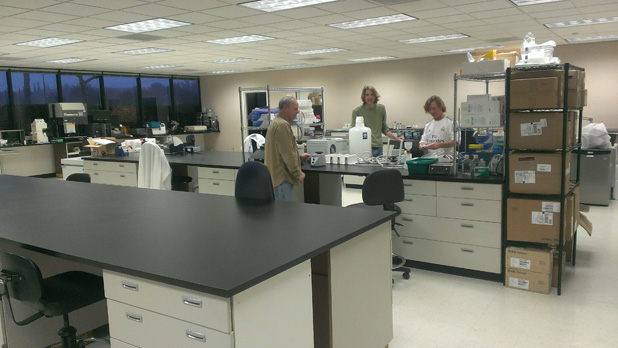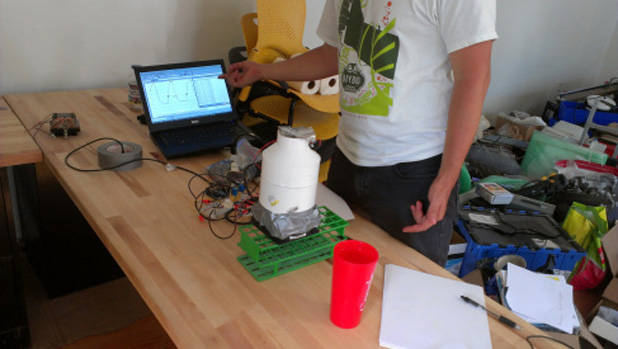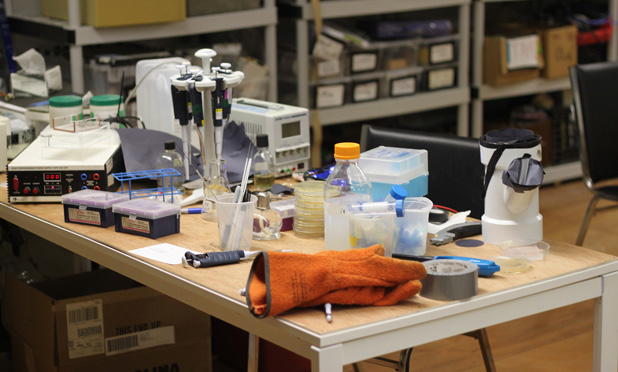In summer 2008, 23-year-old Kay Aull had just graduated from MIT with a degree in bioengineering when she came across a competition for so-called “biohackers” on science fiction website i09.com. Coined “the Mad Science Contest,” it challenged participants to invent new life forms that could be created in a bio lab. She couldn’t help but notice the outrageous comments below the post, where one ambitious (if not delusional) reader was playing out his Jurassic Park fantasies. “People were making claims like they were going to [genetically engineer] a velociraptor,” says Aull, who was working at now-defunct biotech company Codon Devices at the time. “I’m thinking, I do this for a living and we’re not very good at it. Even if you throw all the money you have at it, biohacking is hard.” But the conversation prompted her to ponder, “What can someone who knows what they’re doing accomplish with limited time and resources?” With plans of entering the contest, Aull set aside $500 and cleaned out a half-meter closet in her Cambridge apartment. Short of space and funds, she got creative, installing a vertical shelving unit and buying a $10,000 cell incubator for $90 on ebay. She also purchased a thermal cycler—a table-top device that replicates segments of DNA—and a high-voltage power supply for roughly $100. She used a rice cooker with a whiskey tumbler to make distilled water. With a Tupperware container and a power drill, she built a makeshift centrifuge. She bought biomedical compounds, restriction enzymes, and plasmids online. And for her first experiment, in which she genetically engineered E. coli into a completely new life form, she took second place in the i09.com contest.
Scientific Inquiry Returns to its Root
There was a time in our not-so-distant history when scientific work like this routinely came from those outside of the profession. From the Renaissance to the early 1900s, financially independent “hobbyists” like Charles Darwin, Albert Einstein, Sir Isaac Newton, Antoine Lavoisier (“the father of modern chemistry”) and surgeon James Braid could be credited with advancing scientific knowledge. But in today’s world it is universities, huge corporations, and government-funded labs that have largely taken over that mission. Indeed, it’s difficult for anyone outside these institutions to secure the funding, equipment, or even credibility needed to perform and disseminate scientific work. However, change may be afoot—and PHDs, researchers, entrepreneurs, and engineers will be the first to tell you that the 20th century scientific model is evolving.
In 2008 and 2009, while Aull was piecing together her closet lab, a small movement in the biology community was gaining momentum. DIYbio, otherwise known as “biohacking,” was emerging in the form of meetup groups and basement wetlabs, as biotech enthusiasts took an otherwise exclusive institution and opened up the doors for engineers, programmers, ex-scientists, entrepreneurs—anyone with an interest—to participate in problem solving at the ground level. Everyone was comparing this new breed of hacker to the computer hobbyists who revolutionized the personal computer decades ago: Steve Jobs and Steve Wozniak, Bill Hewlett and Dave Packard, all who started tinkering in their garages. The difference is these folks aren’t programming computers, they’re coding DNA.
A few years before Aull entered the i09 contest, her father had been diagnosed with hemochromatosis, a hereditary disorder that causes the body to absorb too much iron. It’s manageable once detected, but it’s often misdiagnosed, which can be fatal. As she watched others in her family go through genetic testing, she couldn’t help but notice how terrified they were of the entire process. “They were intimidated. It was like black magic, like, ‘Here, read this, find out if you have the family curse.’ So I wanted to design a simple test that would allow someone to physically see a mutation they might have, in order to demystify the process,” she says.
To run the test, she needed a specific sequence of DNA as a primer, one that would bind to any genes containing the hemochromatosis mutation. These days, with the advent of DNA sequencing companies, getting a sequence made from scratch is as easy as ordering it for 30 cents a letter online. Once her custom sequence arrived, all she had to do was swab her cheek, mix it with the primer, put it in the thermal cycler, and wait. To separate the mixed population of DNA, Aull used gel electrophoresis: The results were positive.
Despite the bad news, Aull says it was easier to take because she was educated in genomics, not to mention she didn’t have to spend thousands of dollars on a traditional test. “Everyone has these deep dark genetic secrets,” Aull told Marcus Wohlsen for his 2011 book Biopunk, chronicling the DIYbio movement. “Knowledge is complicated, but ignorance is not better. I think the most important thing about DIYbio is it’s something you can do, too. It’s not magic. It’s chemistry.”
Today, not all biohacking takes place in the closets and kitchens of the biocurious. In the past 5 years, community labs have been popping up across the globe, particularly in hubs of innovation like San Francisco’s Silicon Valley and in cities like New York, Boston, London, and Singapore. A world-wide online network, DIYbio.org, (started in 2008 by Cambridge, Massachusetts hackers Jason Bobe and Mackenzie Cowell, who are often labeled pioneers of the movement), connects citizen scientists with one another and also with hacker spaces where they can work, usually for a small fee or donation. Often stocked with previously discarded or homemade equipment, these labs might not be fancy but they get the job done.
From Bio to Tech and Beyond
On the top floor of Brooklyn’s Metropolitan Exchange (MEx) building—an old bank that now houses a design, technology, and research co-op of the same name—Ellen Jorgensen is rebranding biotech. As the executive director of Genspace, New York City’s community biology lab, she educates and oversees amateur scientists so they can safely carry out projects like extracting DNA or creating an arsenic sensor for contaminated water. Since their main source of funding comes from classes and small membership fees, most of the equipment has been upcycled: Lab benches were constructed from old restaurant countertops, and PCR machines and centrifuges were salvaged from a biotech company that had downsized.
Like Aull, Jorgensen also sees an opportunity for DIYbio to foster greater trust and understanding among the public when it comes to the oft-misunderstood world of biotech. Not only are the doors open for anyone to walk in and learn, but Genspace offers weekly courses like intro to synthetic bio, biohacker bootcamp, and a crash course in biotechnology. “It’s very hard to be scared of genetic engineering when you’ve done it side by side with your 14-year-old daughter in our lab,” she says. “The idea is to demystify the techniques and technology, and in the end, that helps biomedical research because when there’s an established level of trust between science and citizens, the public is less likely to block, say, a proposed facility in their community.”
Trust is something the FBI says it’s working to promote as well. While the bureau claims to have no interest in regulating these labs, the Weapons of Mass Destruction Directorate has established an outreach program in which agents interact with citizen scientists at a local level. Supervisory Special Agent Nathan E. Head says their goal is to identify and educate cooperative parties about potential threats linked with DIYbio. For instance, says Head, “certain individuals have expressed intent to attack the U.S, with bioweapons, and have targeted people with expertise, like scientists, to gain the skills that are required to carry out such an attack. We’re taking a proactive approach by engaging with academia and the DIYbio community to I.D. potential vulnerabilities so those types of events don’t happen. The nefarious actor will need what the scientist has—access to their knowledge, material, and equipment—so we raise awareness and build relationships in these communities, and give them the ability to report certain activity that might need a level of support.”
With a bio safety rating of level one, most DIY labs are limited in that they can’t work with whole animals or human cell lines, but Jorgensen sees the potential for participants in community labs to contribute early work in areas like diagnostics. A prime example, she says, is Jack Andraka, the 15-year-old high school student who won the Intel Prize in 2012 for a pancreatic cancer test he developed in his basement. “[Andraka] wrote to over 200 scientists begging to be able to develop his device in their labs,” she says. “I don’t think a kid like that should have to go through writing 200 emails. I think there should be a place in his neighborhood where he has someone knowledgeable who can help him with his idea. There’s this great potential within DIYbio for scientists to liaise young innovators with the biology community.”

It’s in this spirit that Kevin Lustig, founder and CEO of online pharmaceutical research marketplace Assay Depot (“The Amazon.com for medical researchers,” he calls it), with founder of Open Science Summit, Joseph Jackson, embarked on establishing Bio, Tech and Beyond, a community biotech center in Carlsbad, California, just 40 minutes north of San Diego. “The open-source movement gave us access,” he says, “but what it didn’t provide was a space where people can get together to come up with spontaneous ideas and brainstorm around those ideas. I wanted a place where you can go mingle with like minds and take that idea you always thought was great and turn it into a reality. You might have an engineer talking to a biochemist and coming up with a new process, or maybe a stem cell biologist is talking to an engineer about a new idea for 3-D printing.” For the first time in history, he argues, it’s possible for patients and citizen scientists to take charge of their own medical research, a silver lining for people with rare or orphan diseases that have been deemed unprofitable by the pharmaceutical industry.
The lab opened last July to a tremendous amount of attention from the community and local and state politicians. Individual hobbyists as well as nascent startups have rushed in the doors to test theories or try to get their companies off the ground. Already members are developing new gene expression technologies, natural pesticides, and attempting to create inexpensive lab equipment with 3-D printing, Lustig says.
“The biggest surprise for us has been how much demand there is,” says Lustig. “I think we’ve really turned a corner in entrepreneurship in the United States. A new mindset is taking hold. Everyone in San Diego is thinking about starting a company and how to make their idea a big idea. We want to make every single person into a scientist so they can look around, identify problems, and invent solutions.”
The Future of DIYbio
Avery Louie knew he was hooked on the DIY game when two years ago at a meeting for Public Lab (an international community of open-science enthusiasts particularly interested in DIY innovation and environmental health) he saw a man with what looked like an old VHS cassette case. But rather than outdated reels of tape, it contained a webcam and a piece of a CD shaped like a quarter-slice of a pizza. It was a homemade spectrometer, and the man, Jeffrey Warren, went on to launch a successful Kickstarter campaign and the Homebrew Sensing Project, an initiative to get affordable pollution-detection tools out into the public for measuring things like crude oil contamination in soil.
Louie, who now runs BOSSlab, an open-source science lab for public use in Somerville, Massachusetts, points to a different factor that has helped give rise to DIYbio and citizen science: low cost equipment found on platforms like ebay or Craigslist, and homemade alternatives built by DIYers themselves, much like the spectrometer prototype he saw years ago. “There are people building their own PCR machines,” he says. “A senior in high school is building and selling centrifuges [through the website instructables.com].” And he himself is building gel electrophoresis equipment. “For something that would generally run you $2,500, I got the cost down to $200.”
But despite troves of creativity and general bootstrapping, it’s still unclear whether DIYbio will see the same long-term success that its predecessors in computer electronics have enjoyed. Louie admits that BOSSlab isn’t nearly as productive as it once was, as interest has declined and the lab is used less and less. But Jorgensen is quick to point out the flaw in the comparison. “The difference between bio maker spaces and electronic maker spaces is the time and energy needed to make something. You can bring a kit and solder something and finish it in an evening,” she says, “but if you’re working on the genetic engineering of E. coli—or even bacterial transformation—you’re not going to finish it in an evening. An E. coli won’t divide faster than every twenty minutes or so. You’re always at the mercy of your organism’s lifecycle.”

Still, she says, for those really invested in making a difference, time will never be a deterrent. Lustig agrees and remains convinced that we’re witnessing the future of biotech. “When you lower the barrier to innovation, the results will be earth shattering,” he says. “Remember that Einstein was a citizen scientist. We need another 10 Einsteins, another Steve Jobs. There are people who’ve never had the opportunity to express their talents, and in the same way that Einstein revolutionized our world, they’re going to make breakthroughs we can’t even understand yet. So how do we find them? We lower the barriers.”
Additional Reading
- “Seven Myths & Realities about Do-It-Yourself Biology,” by Daniel Grushkin, Todd Kuiken, Ph.D., Piers Miller, Ph.D. November 2010.
- “Biopunk: Solving Biotech’s Biggest Problems in Kitchens and Garages,” by Marcus Wohlsen, 2012.
- “Bio-Punk: Stories from the Far Side of Research,” by Ra Page, 2013.
- “Biohackers: The Politics of Open Science,” by Alessandro Delfanti, 2013.



